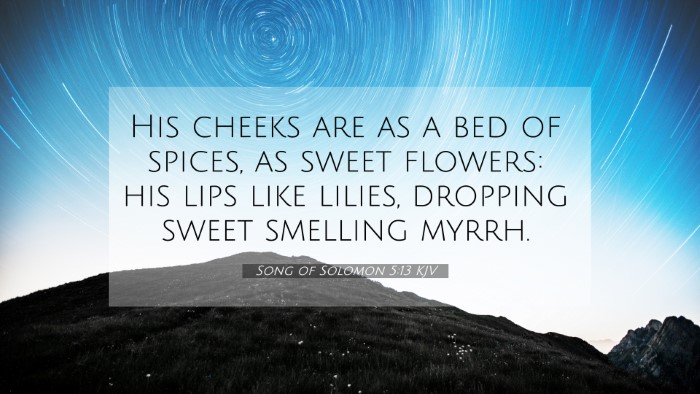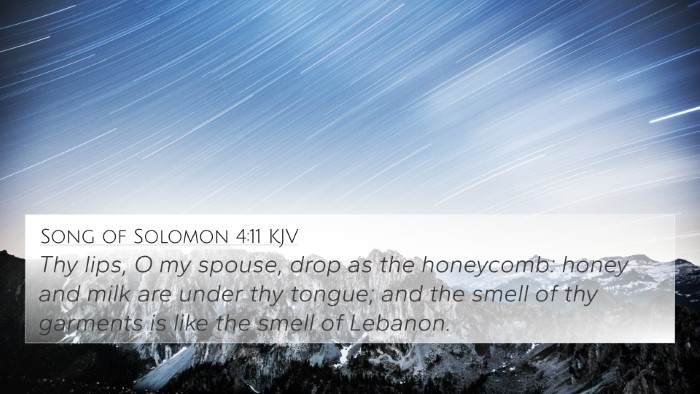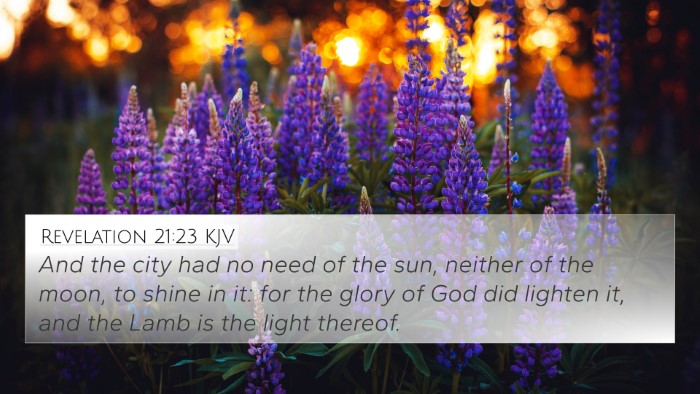Meaning and Interpretation of Song of Solomon 5:13
The verse Song of Solomon 5:13 presents a profound illustration of love and desire that has captured the attention of theologians throughout history. This verse states:
"His cheeks are as a bed of spices, as sweet flowers: his lips like lilies, dropping sweet smelling myrrh."
In this passage, the beloved is described with rich, aromatic imagery which portrays not only beauty but also the sweetness of his character. The following analysis compiles insights from various public domain commentaries to deepen understanding.
Commentary Insights
-
Matthew Henry: Henry emphasizes the use of vivid and fragrant imagery in the Song of Solomon. He notes that the physical characteristics described not only showcase the beloved's attractiveness but also symbolize the spiritual and emotional sweetness found in love. This biblical poetry uses metaphorical language to convey the depth of affection and admiration.
-
Albert Barnes: Barnes highlights the significance of the aromatic descriptions, connecting them to the cultural practices of the time, whereby spices and fragrances represented luxury and desirability. The beloved's beauty is intimately tied to his character, represented through the metaphors of "spices" and "sweet flowers," which indicate the speaker’s perception of an ideal partner.
-
Adam Clarke: Clarke elucidates the imagery further by explaining that the descriptions illustrate the inner qualities of the beloved. The vibrant metaphors suggest a character that is full of life and tenderness, reinforcing the bond of love. Clarke also mentions the importance of understanding the cultural context in which these metaphors would resonate with its original audience.
Bible Verse Cross-References
This verse connects with a variety of other scriptures that contribute to its meaning. Below are 10 relevant cross-references:
- Song of Solomon 4:11: "Thy lips, O my spouse, drop as the honeycomb: honey and milk are under thy tongue; and the smell of thy garments is like the smell of Lebanon." This verse continues the theme of sweetness in love.
- Proverbs 27:9: "Ointment and perfume rejoice the heart: so doth the sweetness of a man's friend by hearty counsel." This reflects the joy and sweetness found in close relationships.
- Philippians 4:18: "But I have all, and abound: I am full, having received of Epaphroditus the things which were sent from you, an odour of a sweet smell, a sacrifice acceptable, well pleasing to God." This connects the idea of perceived sweetness to worship and relationships.
- Revelation 8:3-4: The fragrant incense described represents the prayers of the saints, linking spiritual fragrance with personal devotion.
- Psalm 45:8: "All thy garments smell of myrrh, and aloes, and cassia, out of the ivory palaces, whereby they have made thee glad." The description of garments relates to the beloved's captivating fragrance.
- 1 Peter 3:4: "But let it be the hidden man of the heart, in that which is not corruptible, even the ornament of a meek and quiet spirit, which is in the sight of God of great price." This reflects the inner beauty that is treasured above outward appearance.
- 2 Corinthians 2:14: "Now thanks be unto God, which always causeth us to triumph in Christ, and maketh manifest the savour of his knowledge by us in every place." This showcases the concept of fragrance as a representation of knowledge and relationship, much like that found in Song of Solomon.
- Matthew 12:34: "For out of the abundance of the heart the mouth speaketh." The sweetness of loving words emanates from the heart, paralleling the description of the beloved's lips.
- John 12:3: "Then took Mary a pound of ointment of spikenard, very costly, and anointed the feet of Jesus, and wiped his feet with her hair: and the house was filled with the odour of the ointment." Here, the use of fragrance emphasizes love, value, and devotion.
- 1 John 3:1: "Behold, what manner of love the Father hath bestowed upon us, that we should be called the sons of God." This speaks to the profound nature of love, echoing the sentiment found in the Song of Solomon.
Thematic Connections
These connections illustrate the multifaceted theme of love in Scripture, enriching the reader's understanding of how the Song of Solomon reinforces key biblical principles. The linkages between these verses aid in exploring concepts such as:
- Spiritual and emotional sweetness: Like the sweetness of love described in the Song, the Bible often links love with joy and fulfillment.
- Inner beauty versus outer beauty: Many scriptures highlight the importance of inner qualities, paralleling the emphasis on character in the interpretation of Song of Solomon 5:13.
- The nature of divine love: References throughout Scripture to fragrance often relate to how love and devotion are pleasing in God's sight.
- Symbols of sacrifice and devotion: The aroma of sacrifices and the sweetness of love echo through various scriptures, establishing a pattern that culminates in both the Old and New Testaments.
- The relationship between the church and Christ: Themes surrounding love in the Song are often interpreted as representative of Christ's love for His church, linking this poetic imagery to New Testament theology.
Using Cross-Referencing Tools for Deeper Understanding
Engaging with the concept of cross-referencing can enhance the study of Bible verses significantly. Here are some tools and methods for effective Bible cross-referencing:
- Bible concordance: Utilize a concordance to find verses that share similar keywords or themes.
- Bible cross-reference guide: Many study Bibles provide cross-references that lead to connected scriptures.
- Cross-reference Bible study: Employ systematic study approaches to delve deeper into thematic connections across the text.
- Cross-referencing Bible study methods: Explore various methods, such as thematic studies or character analyses, to trace connections across verses.
- Bible reference resources: Use reference books that focus on inter-Biblical dialogues, which discuss connections between different scriptures.
Conclusion
In summary, Song of Solomon 5:13 serves as a beautiful reminder of the richness of love, symbolized through vivid imagery that speaks to the relational aspects of desire and beauty. By using these cross-referencing methods and understanding the thematic connections, one can enrich their interpretation and comprehension of this verse and similar scriptures throughout the Bible.
















